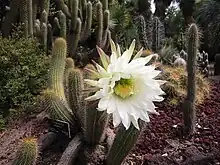| Soehrensia spachiana | |
|---|---|
 | |
| S. spachiana flower | |
| Scientific classification | |
| Kingdom: | Plantae |
| Clade: | Tracheophytes |
| Clade: | Angiosperms |
| Clade: | Eudicots |
| Order: | Caryophyllales |
| Family: | Cactaceae |
| Subfamily: | Cactoideae |
| Genus: | Soehrensia |
| Species: | S. spachiana |
| Binomial name | |
| Soehrensia spachiana | |
| Synonyms | |
|
Cereus spachianus Lem. | |
Soehrensia spachiana, commonly known as the golden torch, (white) torch cactus or golden column, is a species of cactus native to South America. Previously known as Trichocereus spachianus for many years, it is commonly cultivated as a pot or rockery plant worldwide. It has a columnar habit, with a lime-green cylindrical body with 1–2 cm long golden spines.
Description
Soehrensia spachiana grows as a cactus with a columnar habit, reaching 2 m (7 ft) high, with a diameter of 5–6 cm (2–2+1⁄4 in).[2] Vertical branches arise from the base of the plant.[3] Each column has 10–15 rounded ribs. The large areoles are around 1 cm apart, and have wavy yellow hairs. The straight spines are red-yellow initially, fading to white as they age. The central spine is around 1–2 cm (1⁄2–3⁄4 in) long, and is surrounded by 8 to 10 smaller radial spines that are 0.4–1 cm (1⁄4–1⁄2 in) in length. The white flowers are 15 cm (6 in) across and 18–20 cm (7–7+3⁄4 in) long,[2] part of which is an 8 cm long tube. In the northern hemisphere, the flowers appear in June–July and open at night.[4]
 Flowers blooming
Flowers blooming Flowers blooming
Flowers blooming Plant
Plant Close up to spines
Close up to spines
Taxonomy
French botanist Charles Antoine Lemaire described the species as Cereus spachianus in 1839, in honour of his countryman Édouard Spach. The type specimen was collected in Argentina, though where in the country is unclear.[3] Alwin Berger erected the subgenus Trichocereus in 1905, incorporating this species.[5] Vincenzo Riccobono elevated Trichocereus to genus status in 1909,[4] and hence it was for many years known as Trichocereus spachianus. The genus encompassed a number of columnar cacti, before being subsumed into Echinopsis. However, a 2012 genetic analysis of chloroplast DNA indicates Echinopsis is made up of several divergent lineages. E. spachiana was not included in the study but is thought to be related to a Helianthocereus clade.[6]
Distribution and habitat
Soehrensia spachiana is native to western Argentina.[3] It is a declared weed in South Africa.[7]
References
- ↑ "Soehrensia spachiana". Germplasm Resources Information Network. Agricultural Research Service, United States Department of Agriculture. Retrieved 29 May 2023.
- 1 2 Anderson, Edward F. (2001). The Cactus Family. Pentland, Oregon: Timber Press. p. 280. ISBN 978-0-88192-498-5.
- 1 2 3 Britton, Nathaniel Lord; Rose, Joseph Nelson (1919). The Cactaceae : descriptions and illustrations of plants of the cactus family. Vol. 1. Washington, D.C.: Carnegie Institution of Washington. pp. 130–32.
- 1 2 Riccobono, Vincenzo (1909). "Sp. 1° Trichocereus Spachianus (Berg. l. c. p. 73)". Bollettino del R. Orto Botanico di Palermo. 8: 237.
- ↑ Berger, Alwin (1905). "A systematic revision of the genus Cereus Mill". Missouri Botanical Garden Annual Report 1905. 1905: 57–86 [73]. doi:10.2307/2400072. hdl:2027/hvd.32044107241036. JSTOR 2400072.
- ↑ Schlumpberger, Boris O.; Renner, Susanne S. (2012). "Molecular phylogenetics of Echinopsis (Cactaceae): Polyphyly at all levels and convergent evolution of pollination modes and growth forms". American Journal of Botany. 99 (8): 1335–49. doi:10.3732/ajb.1100288. PMID 22859654.
- ↑ Neville, Geoffrey; Howard, W.; Murphy, Sean J.; Preston, Guy (2003). Invasive Alien Species in Southern Africa: a: national reports & directory of resources (PDF) (Report). Cape Town, South Africa: Global Invasive Species Programme. Archived from the original (PDF) on 2016-03-03.